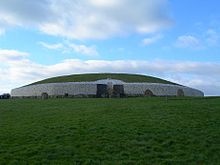- Michael J. O'Kelly
-
Michael J. O'Kelly 
Born 1915 Died 1982 Occupation Archaeologist Nationality Irish Notable work(s) Excavated and restored Newgrange Professor Michael J. O'Kelly (1915–October 1982) was an Irish archaeologist who excavated and restored Newgrange, a Late Stone Age passage tomb in the Boyne Valley, County Meath, Ireland, now a UNESCO World Heritage Site. P. R. Giot wrote of him: "O'Kelly was a man of the field, an expert excavator, an experimental archaeologist, not at all involved in pseudo-marxist, pseudo-freudian, or pseudo-structuralist interpretations. He was an ethno-archaeologist."[1]
Contents
Early Life
O'Kelly was born in Abbeyfeale, County Limerick in 1915. Although he was baptized Michael Joseph, he was known to family and friends as Brian, the name his mother originally wanted, throughout his life.[2] He entered University College, Cork (UCC) in 1934. While still an undergraduate he began fieldwork in 1937. He worked as a surveyor in the excavation of the ring-fort at Garranes, County Cork with Seán P. Ó. Ríordáin, then Professor of Archaeology at UCC. Later that year he moved on to the neolithic site of Lough Gur. After receiving his M.A. he was appointed curator of the new Cork Public Museum in Fitzgerald Park. In 1945 he married his wife Claire, also an archaeologist, who he had met as a student.[3]
Professional Career
In 1946 O'Kelly succeeded his mentor, Professor Ó Ríordáin, as head of the Archaeology Department at UCC, a position he held for 36 years. He excavated continuously, every summer. From 1944 on he was published extensively in scholarly journals.[2] O'Kelly was widely respected as a teacher, for his field work, and for his published articles.
Newgrange
Newgrange, the site O'Kelly would be most associated with, was accidentally discovered in 1699 and attracted a tremendous number of visitors. But as of 1961 it was in extremely poor condition, and there was no public access. That year the archeologist Patrick Hartnett of the Bord Fáilte Eireann (Irish Tourist Board) selected O'Kelly to direct the excavation and to make Newgrange safe for tourists.[4] Work continued every season through to 1975.
On December 21, 1968 O'Kelly confirmed a local legend that the rays of the sun on the midwinter sunrise go straight through the tomb – passing through a small 'roof-box' opening above the doorway to penetrate along the whole length of the passage as far as the center of the chamber.[4] O'Kelly speculated: "I think that the people who built Newgrange built not just a tomb but a house of the dead, a house in which the spirits of special people were going to live for a very long time. To ensure this, the builders took special precautions to make sure the tomb stayed completely dry, as it is to this day. …"[5]
Selected Bibliography
- Irish Antiquity (1981)
- Newgrange: Archaeology, Art and Legend (1982)
- Early Ireland: An Introduction to Irish Prehistory (1989, posthumous)
Notes
- ^ Giot, P.-R. (1983). "Review: Newgrange: archaeology, art and legend.". Antiquity 57 (220): 150. http://antiquity.ac.uk/ant/057/Ant0570149.htm. Retrieved 17 November 2010.
- ^ a b O'Kelly, Michael J.. Claire O'Kelly. ed. Early Ireland: An Introduction to Irish Prehistory. p. xi. ISBN 0521336872.
- ^ "Professor Michael J. O'Kelly excavated and restored Newgrange". Newgrange.com. http://www.newgrange.com/michael-j-okelly.htm. Retrieved November 14, 2010.
- ^ a b Harbison, Peter (1998) [1988]. Pre-Christian Ireland: From the First Settlers to the Early Celts (paperback ed.). London: Thames and Hudson. ISBN 0500278091.
- ^ "Professor Michael J. O'Kelly excavated and restored Newgrange". Knowth.com. http://www.knowth.com/new_grange.htm. Retrieved November 14, 2010.
Categories:- 1915 births
- 1982 deaths
- Irish archaeologists
- People from County Cork
Wikimedia Foundation. 2010.

